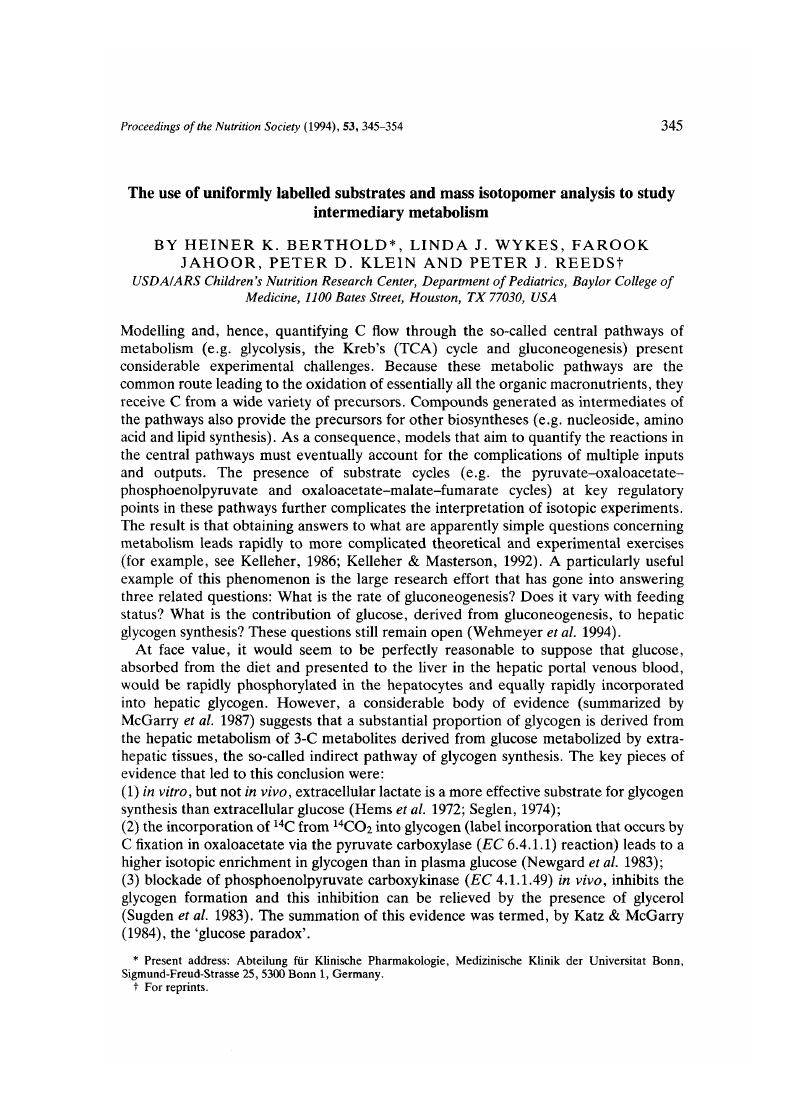Crossref Citations
This article has been cited by the following publications. This list is generated based on data provided by Crossref.
Amarri, S.
and
Weaver, L.T.
1995.
13C-breath tests to measure fat and carbohydrate digestion in clinical practice.
Clinical Nutrition,
Vol. 14,
Issue. 3,
p.
149.
Brunengraber, Henri
Kelleher, Joanne K.
and
Des Rosiers, Christine
1997.
APPLICATIONS OF MASS ISOTOPOMER ANALYSISTO NUTRITION RESEARCH.
Annual Review of Nutrition,
Vol. 17,
Issue. 1,
p.
559.
Livesey, G.
Wilson, P. D. G.
Dainty, J. R.
Brown, J. C.
Faulks, R. M.
Roe, M. A.
Newman, T. A.
Eagles, J.
Mellon, F. A.
and
Greenwood, R. H.
1998.
Simultaneous time-varying systemic appearance of oral and hepatic glucose in adults monitored with stable isotopes.
American Journal of Physiology-Endocrinology and Metabolism,
Vol. 275,
Issue. 4,
p.
E717.
Jeffrey, F.Mark H.
Roach, J.Shawn
Storey, Charles J.
Sherry, A.Dean
and
Malloy, Craig R.
2002.
13C Isotopomer Analysis of Glutamate by Tandem Mass Spectrometry.
Analytical Biochemistry,
Vol. 300,
Issue. 2,
p.
192.
Wielinga, Peter Y.
Wachters-Hagedoorn, Renate E.
Bouter, Brenda
van Dijk, Theo H.
Stellaard, Frans
Nieuwenhuizen, Arie G.
Verkade, Henkjan J.
and
Scheurink, Anton J. W.
2005.
Hydroxycitric acid delays intestinal glucose absorption in rats.
American Journal of Physiology-Gastrointestinal and Liver Physiology,
Vol. 288,
Issue. 6,
p.
G1144.
Bequette, B. J.
Sunny, N. E.
El-Kadi, S. W.
and
Owens, S. L.
2006.
Application of stable isotopes and mass isotopomer distribution analysis to the study of intermediary metabolism of nutrients1.
Journal of Animal Science,
Vol. 84,
Issue. suppl_13,
p.
E50.
Zheng, Wei
Tayyari, Fariba
Gowda, G.A. Nagana
Raftery, Daniel
McLamore, Eric S.
Porterfield, D. Marshall
Donkin, Shawn S.
Bequette, Brian
and
Teegarden, Dorothy
2015.
Altered glucose metabolism in Harvey-rastransformed MCF10A cells.
Molecular Carcinogenesis,
Vol. 54,
Issue. 2,
p.
111.
Previs, Stephen F.
Herath, Kithsiri
Castro-Perez, Jose
Mahsut, Ablatt
Zhou, Haihong
McLaren, David G.
Shah, Vinit
Rohm, Rory J.
Stout, Steven J.
Zhong, Wendy
Wang, Sheng-Ping
Johns, Douglas G.
Hubbard, Brian K.
Cleary, Michele A.
and
Roddy, Thomas P.
2015.
Metabolic Analysis Using Stable Isotopes.
Vol. 561,
Issue. ,
p.
331.
Hu, Q.
Agarwal, U.
and
Bequette, B.J.
2017.
Gluconeogenesis, non-essential amino acid synthesis and substrate partitioning in chicken embryos during later development.
Poultry Science,
Vol. 96,
Issue. 2,
p.
414.





